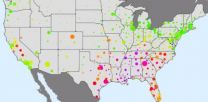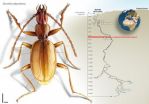(Press-News.org) Friends may be the key to stopping their mates drink walking, a risky behaviour that kills on average two Australians every week, a QUT study has found.
Researcher Dr Ioni Lewis, from QUT's Centre for Accident Research & Road Safety - Queensland (CARRS-Q), said in a survey of young people aged 17 to 25, friends were the strongest influence on their intentions to drink walk.
"Drink walking, or walking while intoxicated in a public place, is linked to increased risk of injury and fatality," Dr Lewis said.
In a survey, published in Transportation Research, more than 50 per cent of participants said they had walked while intoxicated in the previous six months together with evidence that some young people intended to drink walk in the future.
"The study found that the risks associated with drink walking were seen to be less dangerous than drink driving, however, research shows that in Australia on average 100 alcohol-affected pedestrians are killed each year," Dr Lewis said.
"That equates to more than 5 per cent of all road crash fatalities."
Dr Lewis said the study looked at friends, parents and peers and found friends could significantly influence a young person's decision to drink walk.
"Drink walking may occur, for instance, when young people start drinking at home before heading out to pubs or clubs, or when they're walking between licensed venues," she said.
"We now know that when young people who perceive their friends approve of drink walking and believe their friends engage in drink walking, that these young people are more likely to drink walk in the next six months."
She said the study also identified young males as being most at risk, because they considered drink walking to be a low-risk activity.
"If we can turn around the perception of young people that drink walking is not a low-risk activity and it is dangerous, then we may be able to reduce the injuries and fatalities."
Dr Lewis said the next step, which was currently under way in another study, was to design and test safety messages aimed at discouraging drink walking among young people.
The study is looking for 18-25 year olds willing to provide their responses to some anti-drink walking advertising concepts via an online survey.
INFORMATION:
The survey is available at http://survey.qut.edu.au/f/180604/3f20/ or by going to the Participant in Research link on the CARRS-Q homepage http://www.carrsq.qut.edu.au.
Anyone seeking further information about the study can contact Dr Ioni Lewis by emailing i.lewis@qut.edu.au.
The results of the original study were published in a paper titled Does it matter whether friends, parents or peers drink walk? Identifying which normative influences predict young pedestrian's decisions to walk while intoxicated.
Drink walkers do it because their mates think it's okay: QUT study
2014-07-01
ELSE PRESS RELEASES FROM THIS DATE:
EORTC presents European solution for effective cancer drug development
2014-07-01
Drug developers are facing the perfect storm. They are confronted with major patent expiries, increased payer scrutiny, changing priorities, shifting business models, increased risk averseness, increased clinical trial costs, not to mention issues concerning R&D productivity. There needs to be a better way to identify new candidate drugs. There needs to be a new drug development pathway that is compatible with research aimed at understanding the biology of a cancer and simultaneously able to support the design and conduct of subsequent confirmatory trials, but building ...
Unsuspected aspect of immune regulation revealed
2014-07-01
A discovery by Australian immunologists, uncovering an additional role for antibody-making 'B cells', is considered important enough by the American Association of Immunologists to rank it among the top 10% of articles in the latest issue of The Journal of Immunology, off the press today.
The finding by Senior Research Assistant Stacey Walters and Associate Professor Shane Grey, from Sydney's Garvan Institute of Medical Research, shows that B cells also participate in the development of 'regulatory T cells'.
T cells develop in the thymus gland, a soft triangular organ ...
New analysis of 'swine flu' pandemic conflicts with accepted views on how diseases spread
2014-07-01
The most detailed analysis to date of the spread of the H1N1 2009 pandemic influenza virus, known informally as 'swine flu', has found that short-range travel was likely the primary driver for the 2009 pandemic in the United States, in contrast with popularly accepted views on the way diseases spread.
The study, based on data gathered from health insurance claims made throughout 2009, found that international air travel, which was previously thought to be important in the pandemic, played only a minor role in its spread within the US.
A team of researchers from University ...
Cancer risk: Aspirin and smoking affect aging of genes
2014-07-01
The risk of developing cancer increases with age. Factors like smoking and regular aspirin use also affect the risk of cancer – although in the opposite sense. Researchers from the University of Basel were now able to show that aspirin use and smoking both influence aging processes of the female genome that are connected to colorectal cancer. The Journal of the National Cancer Institute has published their results.
Already in the 1990s, scientists discovered that regular use of aspirin over long periods of time decreases the cancer risk. Since then, numerous studies have ...
Analysis of the Chinese facial profile: Contours of the side face in the Tu & Zang ethnic minorities
2014-07-01
Li Haijun and fellow researchers at Minzu University of China, in Beijing, conducted a series of geometric morphometric analyses of the contours of the side face and variations in the Tu and Zang (Tibetan) ethnic minorities from Qinghai Province, in northwestern China.
Their study, entitled "Morphometric analysis of the Chinese facial profile: Contours of the side face and variations in the Tu and Zang ethnic minorities", was published (in Chinese) in the Chinese Science Bulletin, 2014, Vol 59(16).
The team of researchers used advanced digital cameras and image processing ...
A Spaniard and a Portuguese discover a new species of beetle in the world's deepest cave
2014-07-01
The unusual habitat of the Krubera cave in the Western Caucasus remains a mystery. Researchers from two Spanish universities have discovered a new species of beetle in the depths of this cave.
Cave beetles are one of the most iconic species found in subterranean habitats. They were historically the first living organisms described by science that are adapted to the conditions of hypogean or subterranean life.
Now, a Portuguese scientist and a Spaniard have discovered a new species of beetle in the deepest cave known to man; a cave 2,140 metres deep. It is the Krubera ...
Scientists uncover the key to adaptation limits of ocean dwellers
2014-07-01
The simpler, the more heat-resistant – scientists uncover the key to adaptation limits of ocean dwellers
Bremerhaven, Germany, 1 July 2014. The simpler a marine organism is structured, the better it is suited for survival during climate change. Scientists of the Alfred Wegener Institute, Helmholtz Centre for Polar and Marine Research discovered this in a new meta-study, which appears today in the research journal Global Change Biology. For the first time biologists studied the relationship between the complexity of life forms and the ultimate limits of their adaptation ...
The biology of addiction risk looks like addiction
2014-07-01
Philadelphia, PA, July 1, 2014 – Research suggests that people at increased risk for developing addiction share many of the same neurobiological signatures of people who have already developed addiction. This similarity is to be expected, as individuals with family members who have struggled with addiction are over-represented in the population of addicted people.
However, a generation of animal research supports the hypothesis that the addiction process changes the brain in ways that converge with the distinctive neurobiology of the heritable risk for addiction. In other ...
In study of individual neuron activity, key brain region responds to subjective perception
2014-07-01
LOS ANGELES (June 30, 2014) – When evaluating another person's emotions – happy, sad, angry, afraid – humans take cues from facial expressions. Neurons in a part of the brain called the amygdala "fire" in response to the visual stimulation as information is processed by the retina, the amygdala and a network of interconnected brain structures. Some of these regions respond just to the actual features of the face, whereas others respond to how things appear to the viewer, but it is unknown where in the brain this difference arises.
Although the amygdala's importance in ...
Up in flames: Evidence confirms combustion theory
2014-07-01
Researchers at the Department of Energy's Lawrence Berkeley National Lab (Berkeley Lab) and the University of Hawaii have uncovered the first step in the process that transforms gas-phase molecules into solid particles like soot and other carbon-based compounds.
The finding could help combustion chemists make more-efficient, less-polluting fuels and help materials scientists fine-tune their carbon nanotubes and graphene sheets for faster, smaller electronics. In addition, the results could have implications for the burgeoning field of astrochemistry, potentially establishing ...



